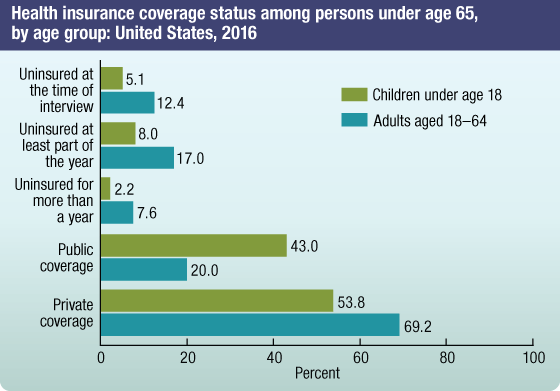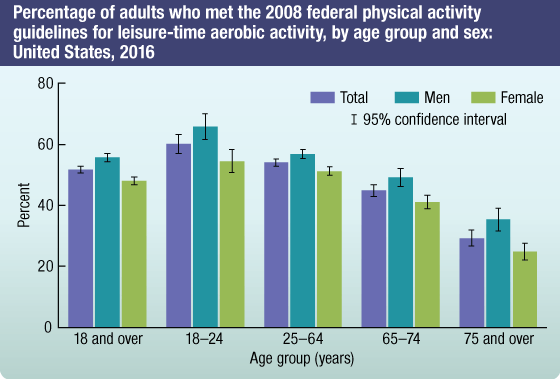National Health Interview Survey
NCHS Fact Sheet, September 2017
About NCHS
The National Center for Health Statistics (NCHS) is the nation’s principal health statistics agency, providing data to identify and address health issues. NCHS compiles statistical information to help guide public health and health policy decisions.
Collaborating with other public and private health partners, NCHS uses a variety of data collection mechanisms to obtain accurate information from multiple sources. This process provides a broad perspective to help understand the population’s health, influences on health, and health outcomes.
National Health Interview Survey
The National Health Interview Survey (NHIS) provides information on the health of the U.S. civilian noninstitutionalized population through confidential interviews conducted in households. NHIS is one of the nation’s largest in-person household health surveys. It provides data for analyzing health trends and tracking progress toward achieving national health objectives.
These data, continuously collected throughout the year, are also used for epidemiological and policy analysis, such as characterizing those with various health conditions, determining barriers to accessing and using appropriate health care, and evaluating federal health programs.
Major Health Topics Addressed
- Physical and mental health status
- Chronic conditions, including asthma and diabetes
- Access to and use of health care services
- Health insurance coverage and type of coverage
- Health-related behaviors, including smoking, alcohol use, and physical activity
- Measures of functioning and activity limitations
- Immunizations
Examples of NHIS Data
Health insurance findings in 2016
- 28.6 million persons of all ages (9.0%) were uninsured at the time of interview—20.0 million fewer persons than in 2010 and no change from 2015.
- Among adults aged 18–64, 69.2% (136.4 million) were covered by private health insurance plans at the time of interview.
- The percentage of adults aged 18–64 who were uninsured at the time of interview decreased from 16.3% in 2014 to 12.8% in 2015.
- The percentage of persons under age 65 who were uninsured at the time of interview varied by state. For example, 3.2% were uninsured in Massachusetts compared with 20.9% in Texas.
- The number of uninsured persons declined in the previous year. In 2015, 28.6 million persons of all ages (9.1%) were uninsured at the time of interview—7.4 million fewer than in 2014

NOTE: Data are based on household interviews of a sample of the civilian noninstitutionalized population.
SOURCE: NCHS, National Health Interview Survey, 2016, Family Core component.
Physical activity
Current federal physical activity guidelines recommend that adults perform at least 150 minutes a week of moderate aerobic activity, 75 minutes a week of vigorous aerobic activity, or an equivalent combination of both.
NHIS leisure-time physical activity data from 2016 show:
- For both sexes combined, as age increased, the percentage of adults who met the 2008 physical activity guidelines for aerobic activity (based on leisure-time activity) decreased.
- For adults aged 18 and over and within all age groups, women were less likely than men to meet the federal physical activity guidelines for aerobic activity (based on leisure-time activity).

SOURCE: CDC/NCHS, National Health Interview Survey, 2016.
Other NHIS data from 2016 show:
- The percentage of persons of all ages with a usual place to go for medical care was highest for non-Hispanic white persons at 89.4% and lowest for Hispanic persons at 83.0%.
- The percentage of current smokers among adults aged 18 and over was highest for non-Hispanic white persons at 17.8% and lowest for Hispanic persons at 10.2%.
- The prevalence of diagnosed diabetes (based on self-report of a diagnosis by a doctor or other health professional) was higher among non-Hispanic black and Hispanic persons than among non-Hispanic white persons.
Wireless substitution data
Twice a year, NHIS releases the most up-to-date estimates of telephone coverage available from the federal government. These estimates, based on in-person interviews, are used by survey researchers and political pollsters to ensure that their random-digit-dial telephone surveys include sufficient numbers of households with only wireless telephones. If telephone surveys do not include wireless-only households, coverage bias could result from differences between persons with and without landline telephones for the substantive variables of interest.
- The second six months of 2016 was the first time that a majority of American homes had only wireless telephones. Preliminary results from the NHIS indicate that 50.8% of homes did not have a landline telephone but at least one wireless telephone.
- The percentage of adults who had at least one heavy drinking day in the past year was substantially higher among wireless-only adults (29.8%) than among adults living in landline households (18.8%).
Challenges and Future Opportunities
- Redesign the survey questionnaire to increase relevance, enhance data quality, and minimize respondent burden, in consultation with other federal agencies, data users, and public health partners
- Test new survey procedures in mid-2018, conduct a field test of the redesigned questionnaire from October through December of 2018, and launch the redesigned instrument in January 2019
- Maintain efforts successful since 2005 to release public-use data files within 6 months of the data collection year
For more information about NCHS, visit https://www.cdc.gov/nchs/.
For more information about NHIS, visit https://www.cdc.gov/nchs/nhis.htm.
- Page last reviewed: September 13, 2017
- Page last updated: September 13, 2017
- Content source:


 ShareCompartir
ShareCompartir